Patient Safety in ICU: A Critical Analysis of RN Staffing Issues
VerifiedAdded on 2023/04/21
|7
|1822
|412
Essay
AI Summary
This essay critically analyzes the impact of registered nurse (RN) staffing levels in Intensive Care Units (ICUs) on patient safety. It highlights how high patient-to-nurse ratios can lead to nurse burnout, medication errors, and decreased patient survival rates. The paper explores the adverse effects of understaffing on both nurses and patients, emphasizing the importance of adequate staffing for improved communication, job satisfaction, and overall quality of care. Recommendations include increasing the number of registered nurses, ensuring sufficient rest periods, and addressing the environmental factors contributing to medication errors and patient mortality in ICUs. The essay concludes that prioritizing nurse well-being and adequate staffing levels are essential for enhancing patient safety and improving outcomes in intensive care settings.
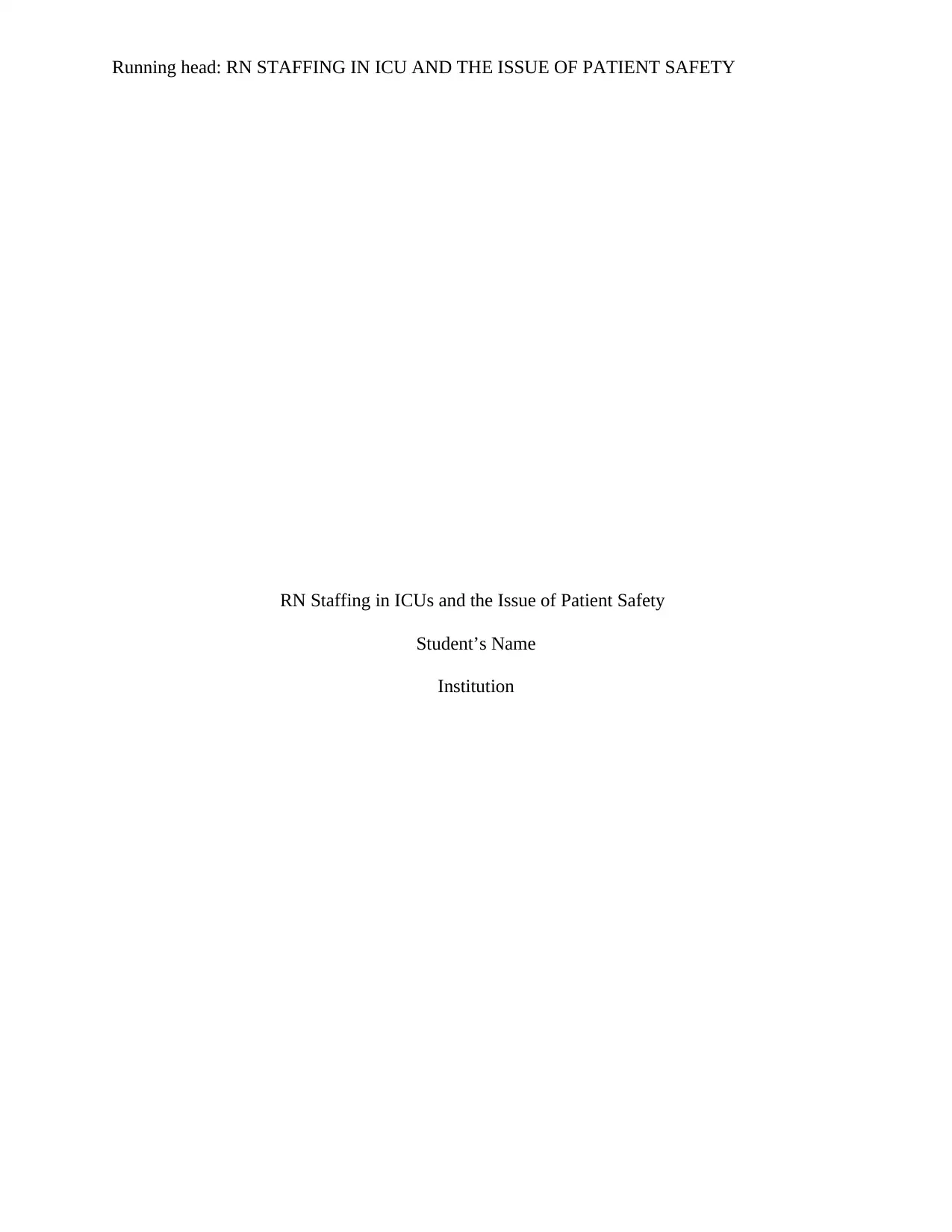
Running head: RN STAFFING IN ICU AND THE ISSUE OF PATIENT SAFETY
RN Staffing in ICUs and the Issue of Patient Safety
Student’s Name
Institution
RN Staffing in ICUs and the Issue of Patient Safety
Student’s Name
Institution
Paraphrase This Document
Need a fresh take? Get an instant paraphrase of this document with our AI Paraphraser
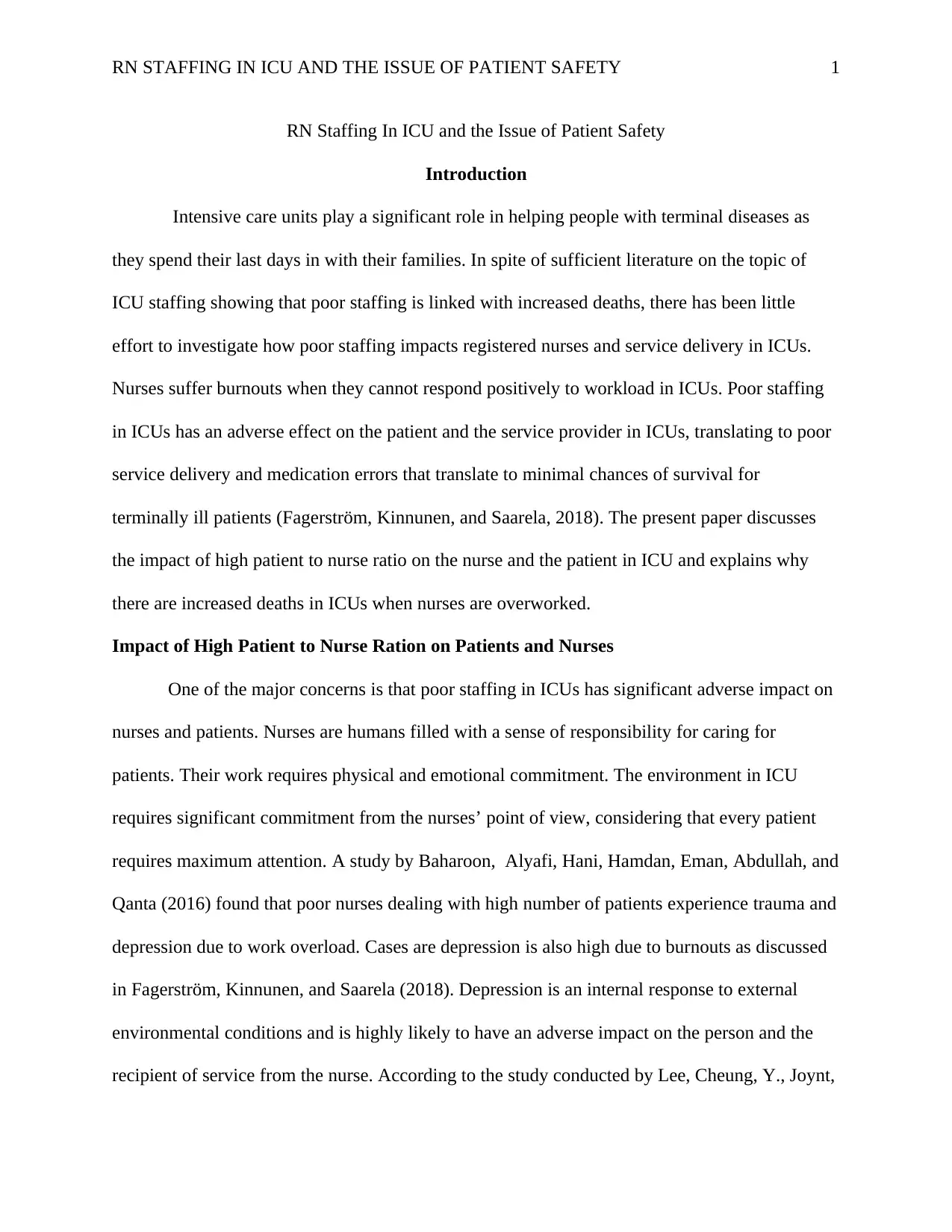
RN STAFFING IN ICU AND THE ISSUE OF PATIENT SAFETY 1
RN Staffing In ICU and the Issue of Patient Safety
Introduction
Intensive care units play a significant role in helping people with terminal diseases as
they spend their last days in with their families. In spite of sufficient literature on the topic of
ICU staffing showing that poor staffing is linked with increased deaths, there has been little
effort to investigate how poor staffing impacts registered nurses and service delivery in ICUs.
Nurses suffer burnouts when they cannot respond positively to workload in ICUs. Poor staffing
in ICUs has an adverse effect on the patient and the service provider in ICUs, translating to poor
service delivery and medication errors that translate to minimal chances of survival for
terminally ill patients (Fagerström, Kinnunen, and Saarela, 2018). The present paper discusses
the impact of high patient to nurse ratio on the nurse and the patient in ICU and explains why
there are increased deaths in ICUs when nurses are overworked.
Impact of High Patient to Nurse Ration on Patients and Nurses
One of the major concerns is that poor staffing in ICUs has significant adverse impact on
nurses and patients. Nurses are humans filled with a sense of responsibility for caring for
patients. Their work requires physical and emotional commitment. The environment in ICU
requires significant commitment from the nurses’ point of view, considering that every patient
requires maximum attention. A study by Baharoon, Alyafi, Hani, Hamdan, Eman, Abdullah, and
Qanta (2016) found that poor nurses dealing with high number of patients experience trauma and
depression due to work overload. Cases are depression is also high due to burnouts as discussed
in Fagerström, Kinnunen, and Saarela (2018). Depression is an internal response to external
environmental conditions and is highly likely to have an adverse impact on the person and the
recipient of service from the nurse. According to the study conducted by Lee, Cheung, Y., Joynt,
RN Staffing In ICU and the Issue of Patient Safety
Introduction
Intensive care units play a significant role in helping people with terminal diseases as
they spend their last days in with their families. In spite of sufficient literature on the topic of
ICU staffing showing that poor staffing is linked with increased deaths, there has been little
effort to investigate how poor staffing impacts registered nurses and service delivery in ICUs.
Nurses suffer burnouts when they cannot respond positively to workload in ICUs. Poor staffing
in ICUs has an adverse effect on the patient and the service provider in ICUs, translating to poor
service delivery and medication errors that translate to minimal chances of survival for
terminally ill patients (Fagerström, Kinnunen, and Saarela, 2018). The present paper discusses
the impact of high patient to nurse ratio on the nurse and the patient in ICU and explains why
there are increased deaths in ICUs when nurses are overworked.
Impact of High Patient to Nurse Ration on Patients and Nurses
One of the major concerns is that poor staffing in ICUs has significant adverse impact on
nurses and patients. Nurses are humans filled with a sense of responsibility for caring for
patients. Their work requires physical and emotional commitment. The environment in ICU
requires significant commitment from the nurses’ point of view, considering that every patient
requires maximum attention. A study by Baharoon, Alyafi, Hani, Hamdan, Eman, Abdullah, and
Qanta (2016) found that poor nurses dealing with high number of patients experience trauma and
depression due to work overload. Cases are depression is also high due to burnouts as discussed
in Fagerström, Kinnunen, and Saarela (2018). Depression is an internal response to external
environmental conditions and is highly likely to have an adverse impact on the person and the
recipient of service from the nurse. According to the study conducted by Lee, Cheung, Y., Joynt,
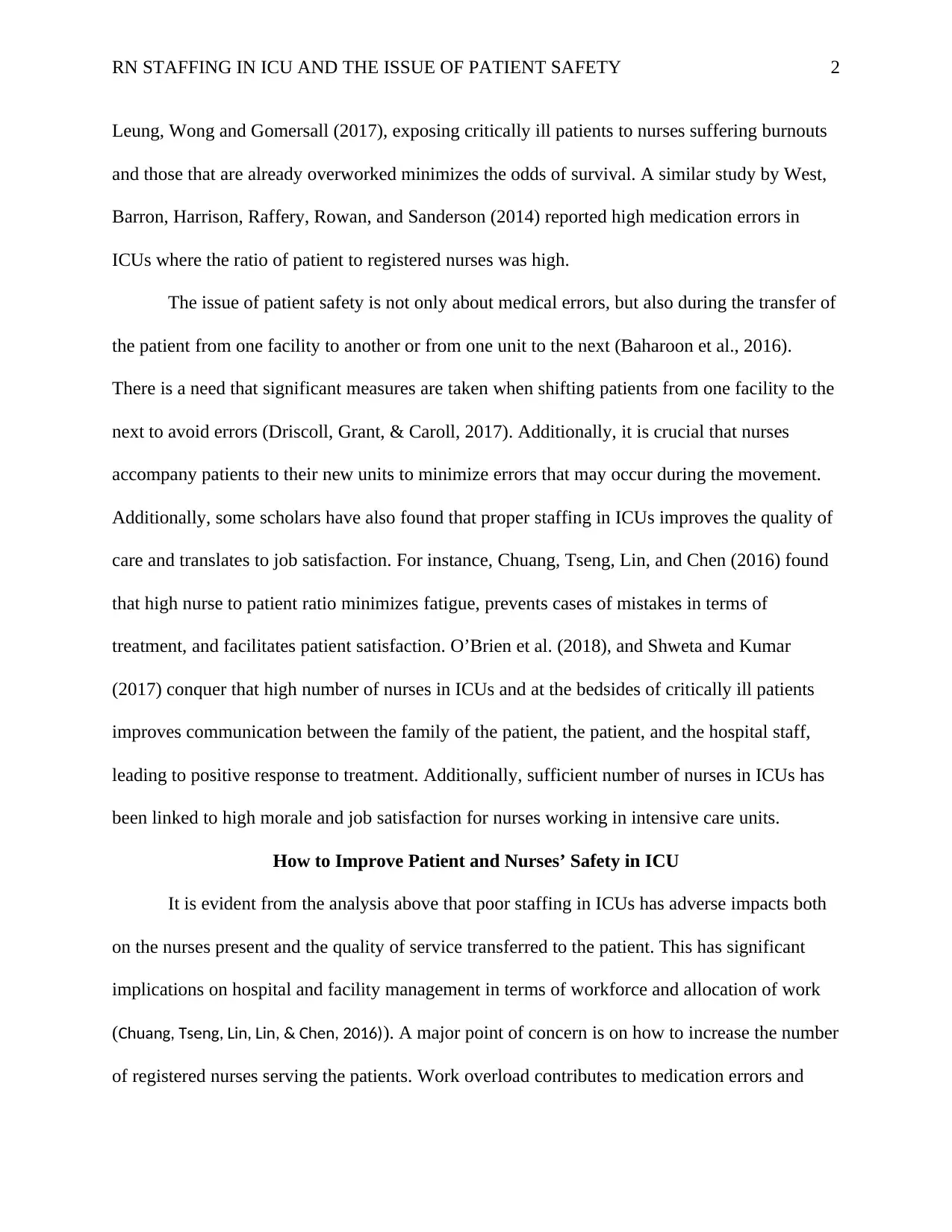
RN STAFFING IN ICU AND THE ISSUE OF PATIENT SAFETY 2
Leung, Wong and Gomersall (2017), exposing critically ill patients to nurses suffering burnouts
and those that are already overworked minimizes the odds of survival. A similar study by West,
Barron, Harrison, Raffery, Rowan, and Sanderson (2014) reported high medication errors in
ICUs where the ratio of patient to registered nurses was high.
The issue of patient safety is not only about medical errors, but also during the transfer of
the patient from one facility to another or from one unit to the next (Baharoon et al., 2016).
There is a need that significant measures are taken when shifting patients from one facility to the
next to avoid errors (Driscoll, Grant, & Caroll, 2017). Additionally, it is crucial that nurses
accompany patients to their new units to minimize errors that may occur during the movement.
Additionally, some scholars have also found that proper staffing in ICUs improves the quality of
care and translates to job satisfaction. For instance, Chuang, Tseng, Lin, and Chen (2016) found
that high nurse to patient ratio minimizes fatigue, prevents cases of mistakes in terms of
treatment, and facilitates patient satisfaction. O’Brien et al. (2018), and Shweta and Kumar
(2017) conquer that high number of nurses in ICUs and at the bedsides of critically ill patients
improves communication between the family of the patient, the patient, and the hospital staff,
leading to positive response to treatment. Additionally, sufficient number of nurses in ICUs has
been linked to high morale and job satisfaction for nurses working in intensive care units.
How to Improve Patient and Nurses’ Safety in ICU
It is evident from the analysis above that poor staffing in ICUs has adverse impacts both
on the nurses present and the quality of service transferred to the patient. This has significant
implications on hospital and facility management in terms of workforce and allocation of work
(Chuang, Tseng, Lin, Lin, & Chen, 2016)). A major point of concern is on how to increase the number
of registered nurses serving the patients. Work overload contributes to medication errors and
Leung, Wong and Gomersall (2017), exposing critically ill patients to nurses suffering burnouts
and those that are already overworked minimizes the odds of survival. A similar study by West,
Barron, Harrison, Raffery, Rowan, and Sanderson (2014) reported high medication errors in
ICUs where the ratio of patient to registered nurses was high.
The issue of patient safety is not only about medical errors, but also during the transfer of
the patient from one facility to another or from one unit to the next (Baharoon et al., 2016).
There is a need that significant measures are taken when shifting patients from one facility to the
next to avoid errors (Driscoll, Grant, & Caroll, 2017). Additionally, it is crucial that nurses
accompany patients to their new units to minimize errors that may occur during the movement.
Additionally, some scholars have also found that proper staffing in ICUs improves the quality of
care and translates to job satisfaction. For instance, Chuang, Tseng, Lin, and Chen (2016) found
that high nurse to patient ratio minimizes fatigue, prevents cases of mistakes in terms of
treatment, and facilitates patient satisfaction. O’Brien et al. (2018), and Shweta and Kumar
(2017) conquer that high number of nurses in ICUs and at the bedsides of critically ill patients
improves communication between the family of the patient, the patient, and the hospital staff,
leading to positive response to treatment. Additionally, sufficient number of nurses in ICUs has
been linked to high morale and job satisfaction for nurses working in intensive care units.
How to Improve Patient and Nurses’ Safety in ICU
It is evident from the analysis above that poor staffing in ICUs has adverse impacts both
on the nurses present and the quality of service transferred to the patient. This has significant
implications on hospital and facility management in terms of workforce and allocation of work
(Chuang, Tseng, Lin, Lin, & Chen, 2016)). A major point of concern is on how to increase the number
of registered nurses serving the patients. Work overload contributes to medication errors and
⊘ This is a preview!⊘
Do you want full access?
Subscribe today to unlock all pages.

Trusted by 1+ million students worldwide
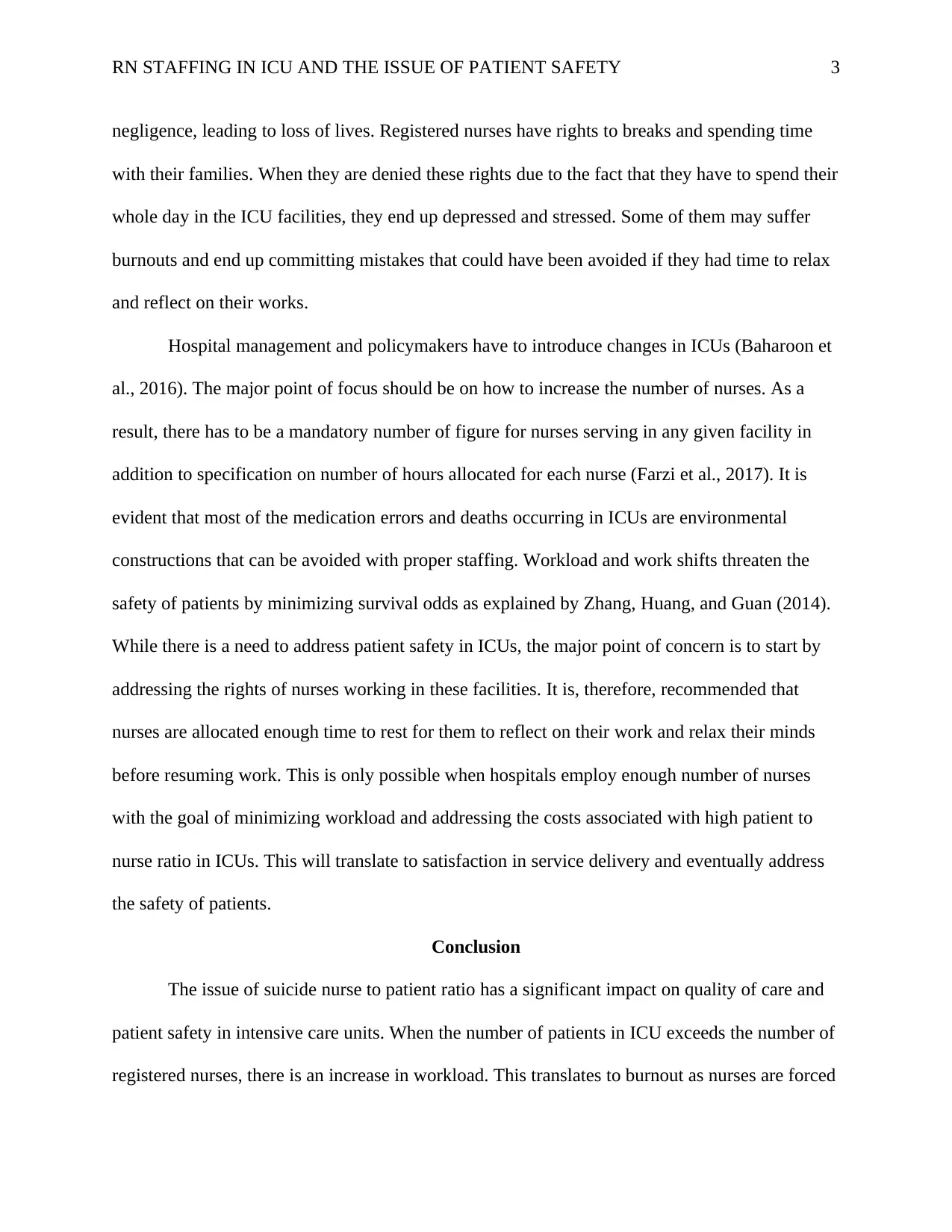
RN STAFFING IN ICU AND THE ISSUE OF PATIENT SAFETY 3
negligence, leading to loss of lives. Registered nurses have rights to breaks and spending time
with their families. When they are denied these rights due to the fact that they have to spend their
whole day in the ICU facilities, they end up depressed and stressed. Some of them may suffer
burnouts and end up committing mistakes that could have been avoided if they had time to relax
and reflect on their works.
Hospital management and policymakers have to introduce changes in ICUs (Baharoon et
al., 2016). The major point of focus should be on how to increase the number of nurses. As a
result, there has to be a mandatory number of figure for nurses serving in any given facility in
addition to specification on number of hours allocated for each nurse (Farzi et al., 2017). It is
evident that most of the medication errors and deaths occurring in ICUs are environmental
constructions that can be avoided with proper staffing. Workload and work shifts threaten the
safety of patients by minimizing survival odds as explained by Zhang, Huang, and Guan (2014).
While there is a need to address patient safety in ICUs, the major point of concern is to start by
addressing the rights of nurses working in these facilities. It is, therefore, recommended that
nurses are allocated enough time to rest for them to reflect on their work and relax their minds
before resuming work. This is only possible when hospitals employ enough number of nurses
with the goal of minimizing workload and addressing the costs associated with high patient to
nurse ratio in ICUs. This will translate to satisfaction in service delivery and eventually address
the safety of patients.
Conclusion
The issue of suicide nurse to patient ratio has a significant impact on quality of care and
patient safety in intensive care units. When the number of patients in ICU exceeds the number of
registered nurses, there is an increase in workload. This translates to burnout as nurses are forced
negligence, leading to loss of lives. Registered nurses have rights to breaks and spending time
with their families. When they are denied these rights due to the fact that they have to spend their
whole day in the ICU facilities, they end up depressed and stressed. Some of them may suffer
burnouts and end up committing mistakes that could have been avoided if they had time to relax
and reflect on their works.
Hospital management and policymakers have to introduce changes in ICUs (Baharoon et
al., 2016). The major point of focus should be on how to increase the number of nurses. As a
result, there has to be a mandatory number of figure for nurses serving in any given facility in
addition to specification on number of hours allocated for each nurse (Farzi et al., 2017). It is
evident that most of the medication errors and deaths occurring in ICUs are environmental
constructions that can be avoided with proper staffing. Workload and work shifts threaten the
safety of patients by minimizing survival odds as explained by Zhang, Huang, and Guan (2014).
While there is a need to address patient safety in ICUs, the major point of concern is to start by
addressing the rights of nurses working in these facilities. It is, therefore, recommended that
nurses are allocated enough time to rest for them to reflect on their work and relax their minds
before resuming work. This is only possible when hospitals employ enough number of nurses
with the goal of minimizing workload and addressing the costs associated with high patient to
nurse ratio in ICUs. This will translate to satisfaction in service delivery and eventually address
the safety of patients.
Conclusion
The issue of suicide nurse to patient ratio has a significant impact on quality of care and
patient safety in intensive care units. When the number of patients in ICU exceeds the number of
registered nurses, there is an increase in workload. This translates to burnout as nurses are forced
Paraphrase This Document
Need a fresh take? Get an instant paraphrase of this document with our AI Paraphraser
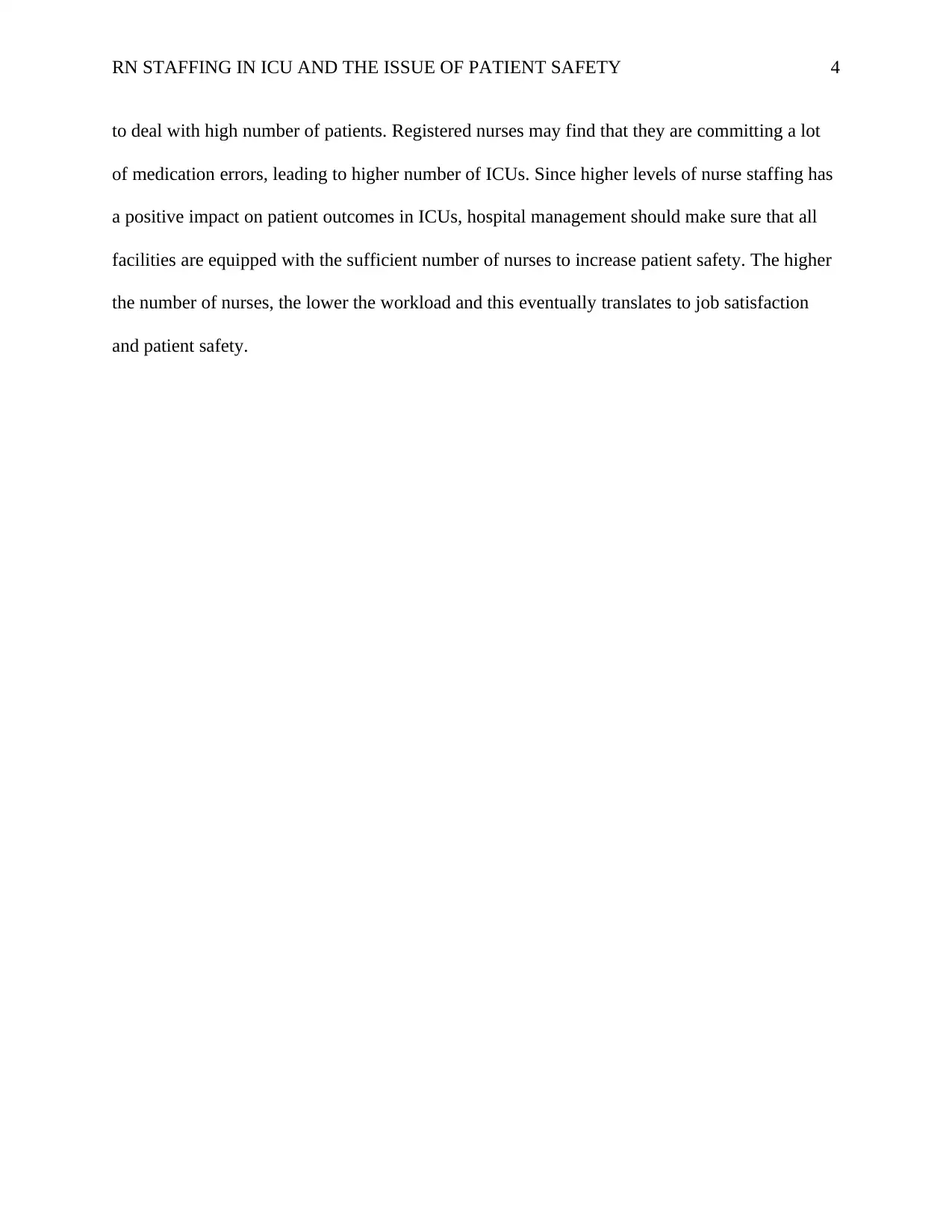
RN STAFFING IN ICU AND THE ISSUE OF PATIENT SAFETY 4
to deal with high number of patients. Registered nurses may find that they are committing a lot
of medication errors, leading to higher number of ICUs. Since higher levels of nurse staffing has
a positive impact on patient outcomes in ICUs, hospital management should make sure that all
facilities are equipped with the sufficient number of nurses to increase patient safety. The higher
the number of nurses, the lower the workload and this eventually translates to job satisfaction
and patient safety.
to deal with high number of patients. Registered nurses may find that they are committing a lot
of medication errors, leading to higher number of ICUs. Since higher levels of nurse staffing has
a positive impact on patient outcomes in ICUs, hospital management should make sure that all
facilities are equipped with the sufficient number of nurses to increase patient safety. The higher
the number of nurses, the lower the workload and this eventually translates to job satisfaction
and patient safety.
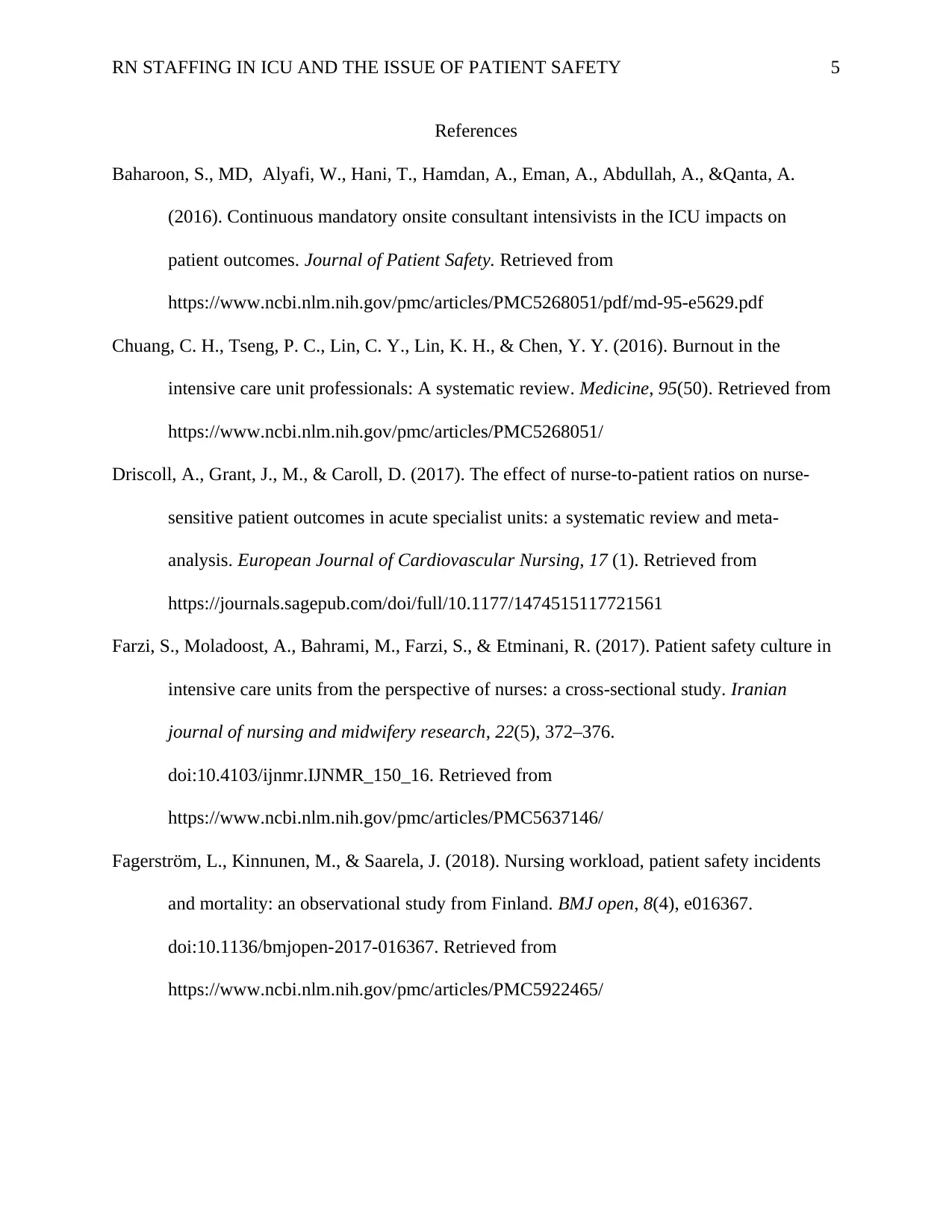
RN STAFFING IN ICU AND THE ISSUE OF PATIENT SAFETY 5
References
Baharoon, S., MD, Alyafi, W., Hani, T., Hamdan, A., Eman, A., Abdullah, A., &Qanta, A.
(2016). Continuous mandatory onsite consultant intensivists in the ICU impacts on
patient outcomes. Journal of Patient Safety. Retrieved from
https://www.ncbi.nlm.nih.gov/pmc/articles/PMC5268051/pdf/md-95-e5629.pdf
Chuang, C. H., Tseng, P. C., Lin, C. Y., Lin, K. H., & Chen, Y. Y. (2016). Burnout in the
intensive care unit professionals: A systematic review. Medicine, 95(50). Retrieved from
https://www.ncbi.nlm.nih.gov/pmc/articles/PMC5268051/
Driscoll, A., Grant, J., M., & Caroll, D. (2017). The effect of nurse-to-patient ratios on nurse-
sensitive patient outcomes in acute specialist units: a systematic review and meta-
analysis. European Journal of Cardiovascular Nursing, 17 (1). Retrieved from
https://journals.sagepub.com/doi/full/10.1177/1474515117721561
Farzi, S., Moladoost, A., Bahrami, M., Farzi, S., & Etminani, R. (2017). Patient safety culture in
intensive care units from the perspective of nurses: a cross-sectional study. Iranian
journal of nursing and midwifery research, 22(5), 372–376.
doi:10.4103/ijnmr.IJNMR_150_16. Retrieved from
https://www.ncbi.nlm.nih.gov/pmc/articles/PMC5637146/
Fagerström, L., Kinnunen, M., & Saarela, J. (2018). Nursing workload, patient safety incidents
and mortality: an observational study from Finland. BMJ open, 8(4), e016367.
doi:10.1136/bmjopen-2017-016367. Retrieved from
https://www.ncbi.nlm.nih.gov/pmc/articles/PMC5922465/
References
Baharoon, S., MD, Alyafi, W., Hani, T., Hamdan, A., Eman, A., Abdullah, A., &Qanta, A.
(2016). Continuous mandatory onsite consultant intensivists in the ICU impacts on
patient outcomes. Journal of Patient Safety. Retrieved from
https://www.ncbi.nlm.nih.gov/pmc/articles/PMC5268051/pdf/md-95-e5629.pdf
Chuang, C. H., Tseng, P. C., Lin, C. Y., Lin, K. H., & Chen, Y. Y. (2016). Burnout in the
intensive care unit professionals: A systematic review. Medicine, 95(50). Retrieved from
https://www.ncbi.nlm.nih.gov/pmc/articles/PMC5268051/
Driscoll, A., Grant, J., M., & Caroll, D. (2017). The effect of nurse-to-patient ratios on nurse-
sensitive patient outcomes in acute specialist units: a systematic review and meta-
analysis. European Journal of Cardiovascular Nursing, 17 (1). Retrieved from
https://journals.sagepub.com/doi/full/10.1177/1474515117721561
Farzi, S., Moladoost, A., Bahrami, M., Farzi, S., & Etminani, R. (2017). Patient safety culture in
intensive care units from the perspective of nurses: a cross-sectional study. Iranian
journal of nursing and midwifery research, 22(5), 372–376.
doi:10.4103/ijnmr.IJNMR_150_16. Retrieved from
https://www.ncbi.nlm.nih.gov/pmc/articles/PMC5637146/
Fagerström, L., Kinnunen, M., & Saarela, J. (2018). Nursing workload, patient safety incidents
and mortality: an observational study from Finland. BMJ open, 8(4), e016367.
doi:10.1136/bmjopen-2017-016367. Retrieved from
https://www.ncbi.nlm.nih.gov/pmc/articles/PMC5922465/
⊘ This is a preview!⊘
Do you want full access?
Subscribe today to unlock all pages.

Trusted by 1+ million students worldwide
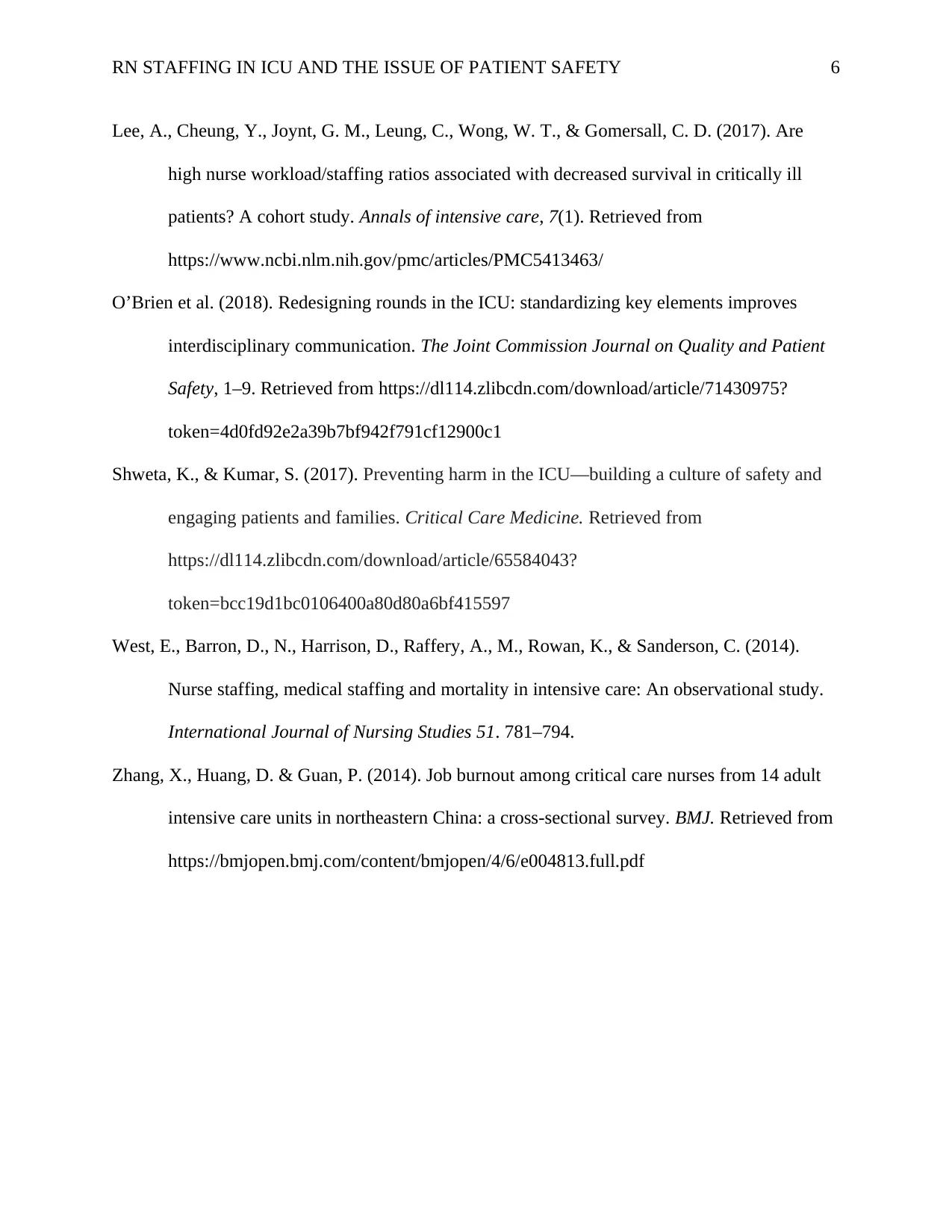
RN STAFFING IN ICU AND THE ISSUE OF PATIENT SAFETY 6
Lee, A., Cheung, Y., Joynt, G. M., Leung, C., Wong, W. T., & Gomersall, C. D. (2017). Are
high nurse workload/staffing ratios associated with decreased survival in critically ill
patients? A cohort study. Annals of intensive care, 7(1). Retrieved from
https://www.ncbi.nlm.nih.gov/pmc/articles/PMC5413463/
O’Brien et al. (2018). Redesigning rounds in the ICU: standardizing key elements improves
interdisciplinary communication. The Joint Commission Journal on Quality and Patient
Safety, 1–9. Retrieved from https://dl114.zlibcdn.com/download/article/71430975?
token=4d0fd92e2a39b7bf942f791cf12900c1
Shweta, K., & Kumar, S. (2017). Preventing harm in the ICU—building a culture of safety and
engaging patients and families. Critical Care Medicine. Retrieved from
https://dl114.zlibcdn.com/download/article/65584043?
token=bcc19d1bc0106400a80d80a6bf415597
West, E., Barron, D., N., Harrison, D., Raffery, A., M., Rowan, K., & Sanderson, C. (2014).
Nurse staffing, medical staffing and mortality in intensive care: An observational study.
International Journal of Nursing Studies 51. 781–794.
Zhang, X., Huang, D. & Guan, P. (2014). Job burnout among critical care nurses from 14 adult
intensive care units in northeastern China: a cross-sectional survey. BMJ. Retrieved from
https://bmjopen.bmj.com/content/bmjopen/4/6/e004813.full.pdf
Lee, A., Cheung, Y., Joynt, G. M., Leung, C., Wong, W. T., & Gomersall, C. D. (2017). Are
high nurse workload/staffing ratios associated with decreased survival in critically ill
patients? A cohort study. Annals of intensive care, 7(1). Retrieved from
https://www.ncbi.nlm.nih.gov/pmc/articles/PMC5413463/
O’Brien et al. (2018). Redesigning rounds in the ICU: standardizing key elements improves
interdisciplinary communication. The Joint Commission Journal on Quality and Patient
Safety, 1–9. Retrieved from https://dl114.zlibcdn.com/download/article/71430975?
token=4d0fd92e2a39b7bf942f791cf12900c1
Shweta, K., & Kumar, S. (2017). Preventing harm in the ICU—building a culture of safety and
engaging patients and families. Critical Care Medicine. Retrieved from
https://dl114.zlibcdn.com/download/article/65584043?
token=bcc19d1bc0106400a80d80a6bf415597
West, E., Barron, D., N., Harrison, D., Raffery, A., M., Rowan, K., & Sanderson, C. (2014).
Nurse staffing, medical staffing and mortality in intensive care: An observational study.
International Journal of Nursing Studies 51. 781–794.
Zhang, X., Huang, D. & Guan, P. (2014). Job burnout among critical care nurses from 14 adult
intensive care units in northeastern China: a cross-sectional survey. BMJ. Retrieved from
https://bmjopen.bmj.com/content/bmjopen/4/6/e004813.full.pdf
1 out of 7
Related Documents
Your All-in-One AI-Powered Toolkit for Academic Success.
+13062052269
info@desklib.com
Available 24*7 on WhatsApp / Email
![[object Object]](/_next/static/media/star-bottom.7253800d.svg)
Unlock your academic potential
Copyright © 2020–2025 A2Z Services. All Rights Reserved. Developed and managed by ZUCOL.





